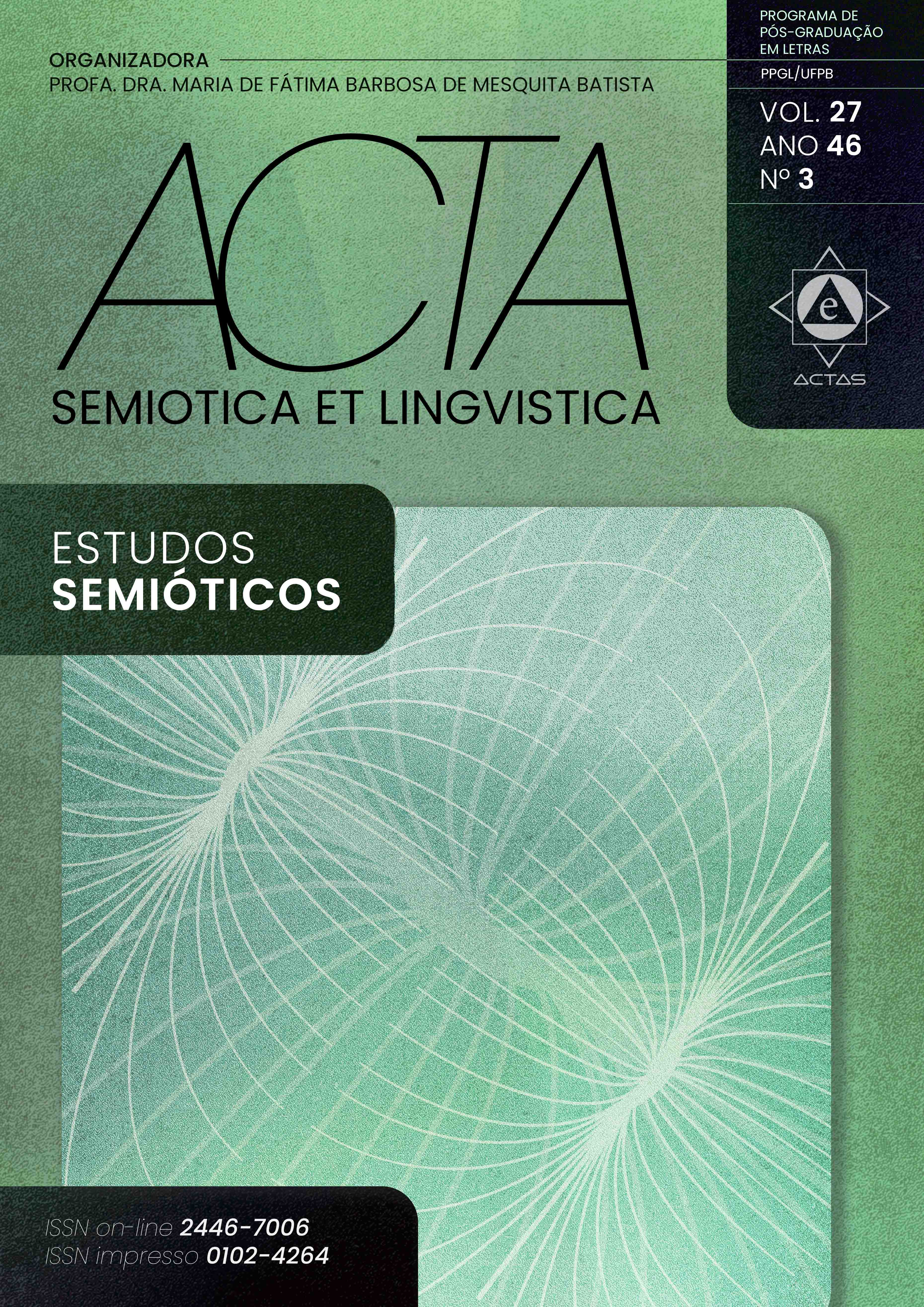MULTIMODAL SIMULACRUM AND VISUAL SEMIOSIS
DOI:
https://doi.org/10.22478/ufpb.2446-7006.46v27n3.64720Resumo
This article addresses the problem of mental imagery in the interpretation of iconic signifieds. It examines, with regard tothe iconic sign, François Rastier’s hypothesis that “mental images are constrained (but not entirely determined) by signifieds [in context]” (RASTIER, 1991, p. 242), it being understood that, in Rastier’s systematics, the signified, which belongs to the semiotic
sphere, is distinguished from the concept, which belongs to the cognitive sphere. More precisely, it is a matter of transposing to visual semiosis the concept of the multimodal simulacrum proposed by Rastier (1991), a kind of eidetic content that would be generated or at least solicited by the semantic structure of the message. In this hypothesis, the interpretation of the iconic sign would cognitively elicit presentations that potentially combine different represented sensory modalities, and also possibly abstract features. The conceptual transposition proposed in this article integrates the results of work in the field of cognitive psychology on mental imagery with Rastier’s proposals.
Downloads
Referências
DENIS, Michel, Image et cognition. Paris: Presses universitaires de France, 1989.
DENIS, Michel,“Imagerie mentale”. In:Vocabulaire des sciences cognitives, Olivier Houdé (Ed.). Paris: Presses universitaires de France, 2003a, pp. 222-225.
DENIS, Michel,“Représentation”.In:Vocabulaire des sciences cognitives, Olivier Houdé (Ed.). Paris: Presses universitaires de France, 2003b, pp. 382-384.
GROUPE μ, Traité du signe visuel. Paris: Seuil, 1992.
GROUPE μ,Principiasemiotica. Aux sources du sens. Bruxelles: Les Impressions nouvelles, 2015.
HÉBERT, Louis, Introduction à la sémantique des textes. Paris: Honoré Champion, 2001.
HÉBERT, Louis, “Typologie des structures du signe: le signe selon le Groupe μ.” Actes Sémiotiques, n. 113, 2010, http://epublications.unilim.fr/revues/as/1761 (accessed May 6, 2022).
HÉBERT, Louis,Dictionnaire de sémiotique (version 15.1). 2021, https://semiotique.org/(accessedMay 6, 2021).
KLINKENBERG, Jean-Marie,Précis de sémiotique générale. Paris: Seuil, 1996.
KURTS-WÖSTE, Lia,“Les formes symboliques artistiques au prisme de la musique: pour une approche trans-sémiotique”.Signata, n. 8, 2017, pp. 341-370, http://journals.openedition.org/signata/1418(accessed May 6, 2022).
LE NY, Jean-François,“Comment (se) représenter les représentations.” In:Les représentations, Stéphane Ehrlich (Ed.), Psychologie française, n. 30, 1985, pp. 231-238.
LUPIEN, Jocelyne,“La polysensorialité dans les discours symboliques plastiques.” In:Action, passion, cognition d’après A. J. Greimas, Pierre Ouellet (Ed.). Québec/Limoges: Nuit blanche éditeur/Pulim, 1997, pp. 247-265.
MISSIRE, Régis,“Examen du concept d’impression référentielle dans la sémantique interprétative
de François Rastier – Du domaine d’objectivité à l’objectivité du domaine”.Champs du signe, n. 12, 2001, pp. 145-160. (unpaginatedfacsimile)
RASTIER, François, Sens et textualité. Limoges: Lambert-Lucas, 1989 (expanded 2nd edition, 2016).
RASTIER, François, Sémantique et recherches cognitives. Paris: Presses universitaires de France, 1991.
Downloads
Publicado
Edição
Seção
Licença
Declaração de Direito Autoral
Os artigos submetidos a revista Acta Semiotica et Lingvistica estão licenciados conforme CC BY. Para mais informações sobre essa forma de licenciamento, consulte: http://creativecommons.org/licenses/by/4.0
A disponibilização é gratuita na Internet, para que os usuários possam ler, fazer download, copiar, distribuir, imprimir, pesquisar ou referenciar o texto integral dos documentos, processá-los para indexação, utilizá-los como dados de entrada de programas para softwares, ou usá-los para qualquer outro propósito legal, sem barreira financeira, legal ou técnica.
1) Autores mantém os direitos autorais e concedem à revista o direito de primeira publicação, com o trabalho simultaneamente licenciado sob a Licença Creative Commons Attribution que permite o compartilhamento do trabalho com reconhecimento da autoria e publicação inicial nesta revista.
2) Autores têm autorização para assumir contratos adicionais separadamente, para distribuição não-exclusiva da versão do trabalho publicada nesta revista (ex.: publicar em repositório institucional ou como capítulo de livro), com reconhecimento de autoria e publicação inicial nesta revista.
3) Autores têm permissão para publicar e distribuir seu trabalho online (ex.: em repositórios institucionais ou na sua página pessoal) a qualquer ponto antes ou durante o processo editorial, já que isso pode gerar alterações produtivas, bem como aumentar o impacto e a citação do trabalho publicado.


